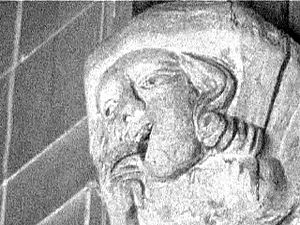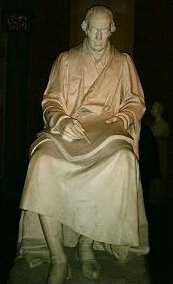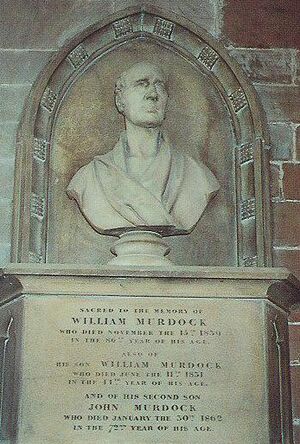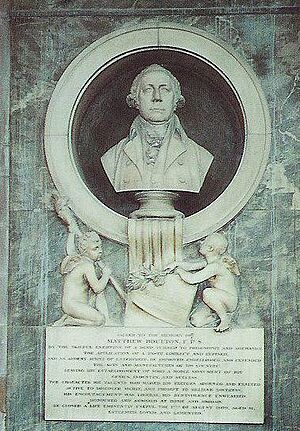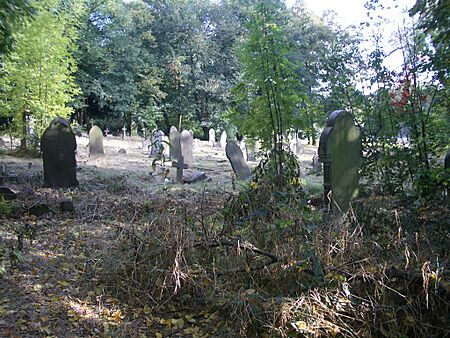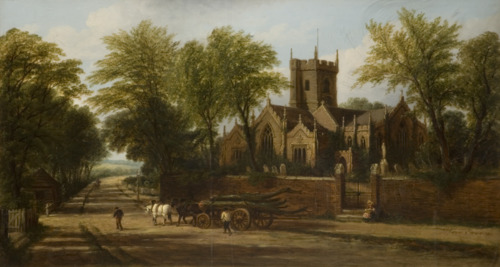St Mary's Church, Handsworth facts for kids
Quick facts for kids St Mary's Church |
|
|---|---|
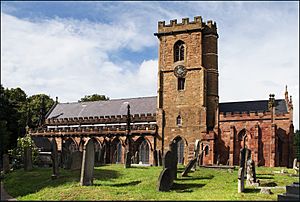
St Mary's Church, Handsworth, Birmingham
|
|
| 52°30′38″N 1°55′9″W / 52.51056°N 1.91917°W | |
| Location | Handsworth, Birmingham |
| Country | England |
| Denomination | Church of England |
| Website | http://handsworthstmary.org/ |
| Administration | |
| Diocese | Birmingham |
| Province | Canterbury |
St Mary's Church, Handsworth, also known as Handsworth Old Church, is a historic Anglican church in Handsworth, Birmingham, England. It is a Grade II* listed building, meaning it is very important. The church grounds cover about ten acres and are next to Handsworth Park. Many famous people from the Industrial Revolution are buried here. Because of this, some people call it the "Cathedral of the Industrial Revolution".
Contents
History of St Mary's Church
Even though the church is linked to the Industrial Revolution, its history goes back much further. The first records for St Mary's began in 1558. The first stone church was built on this spot around 1160. It was a small, simple Norman building. You can still see some Norman parts in the lower sections of the sandstone tower.
Over its long history, St Mary's Church has been rebuilt and changed many times. Big changes happened in 1820 and 1870. The church started as a country church in Staffordshire. It grew to become an important part of Birmingham, which became a huge industrial city.
In 1851, a book about Staffordshire described St Mary's. It said the church was old and had a tower with six bells. It also mentioned two statues of the Wyrley family inside. The book highlighted a special chapel built for the famous engineer, James Watt. This chapel had a beautiful white marble statue of Watt. Another important person, Matthew Boulton, also had a monument in the church.
In 1894, a new church, St Paul's Church, Hamstead, was created from part of St Mary's parish. In 1911, Handsworth parish moved from Staffordshire to Warwickshire. Today, St Mary's is located in the Handsworth area of Birmingham, in the West Midlands county.
Church Organ and Music
A new organ was installed in the church in 1866. It was later replaced in 1895 by a new instrument. This organ was repaired several times over the years. You can find details about it on the National Pipe Organ Register. However, there is no longer a pipe organ used in the church today.
Past Organists of St Mary's
Many talented musicians have played the organ at St Mary's Church. Here are some of them:
- C. Fletcher (from 1843)
- William Elliott (until 1848)
- George W. Elliott (from 1848)
- Henry Price (until 1866)
- Twyford Taylor (1866–1867)
- William T. Taylor (1867-1877)
- Dr. William Thomas Belcher (1878-1883)
- Thomas Troman (1883-1889)
- Charles William Perkins (1889-1891), who was also the Birmingham City Organist
- George John Halford (from 1891)
- Alfred J. Silver (1901-1934)
Church Bells
The church tower received a set of 6 bells in 1701. These bells were rehung in 1868. In 1890, one bell was remade, and two new bells were added. In 1954, a large crack was found in one of the bells. So, in 1955, all the bells were remade by a company in Loughborough. The largest bell weighs about 797 kilograms (1,757 pounds). The new bells were dedicated to family members who helped raise money for them. You can see a list of these names in the church's bell book.
Improving the Churchyard
Since the 1970s, St Mary's churchyard has been quite neglected. It is a closed graveyard, meaning no new burials happen there. There are empty-looking areas where many poor people were buried without coffins or headstones. The churchyard became overgrown, making it hard to see the memorials. Some headstones were broken or unstable.
However, the paths lined with lime trees have been kept clear. This wild area still has a mysterious beauty. Plans are in place to make the graveyard better. The goal is to make it safer and more welcoming, while still keeping its peaceful feel and its importance for wildlife. The aim is also to make it a place where visitors of all ages can learn.
Local community leaders have provided funds for improvements. They hope other groups will also help. The City Council's Landscape Practice Group has created a plan to fix years of neglect. This plan aims to bring about changes similar to the great improvements made in the nearby Handsworth Park between 2000 and 2006.
In March 2006, a new group called "The Friends of St Mary's Churchyard" was formed. This group wants to protect the churchyard as a special place. It's special not only because it's a graveyard, but also because of its links to the founders of the Industrial Age. More recently, it's connected to two important figures in football:
- William McGregor, who helped start the Football League in 1888.
- George Ramsay, whose headstone says "Founder of Aston Villa".
Famous Industrial Revolution Memorials
Three very important figures from the Industrial Revolution are remembered with monuments inside St Mary's Church: James Watt, Matthew Boulton, and William Murdoch.
- James Watt lived in Handsworth. He is famous for inventing the separate condenser, which greatly improved the steam engine.
- Matthew Boulton was an engineer who worked with Watt. Their partnership became one of the most famous in industrial history.
- William Murdoch was another engineer. He improved gas lighting and developed the high-pressure steam engine. He also became a partner of Boulton and Watt.
You can find their monuments in the main part of the church:
- On the north wall, there is a marble bust (a sculpture of the head and shoulders) of Matthew Boulton. It was made by the sculptor John Flaxman.
- On the opposite wall, there is a stone bust of William Murdoch.
- James Watt was buried in the church grounds. Later, when the church was expanded, his tomb ended up inside the building. In a special area called The James Watt Memorial Chapel, there is a marble statue of Watt. This statue was made by Francis Legatt Chantrey, who considered it his favorite work.
Conrad Heinrich Küchler, a German engraver who designed several British coins for Matthew Boulton, is also buried in the churchyard.
Genealogical Records
Between 1980 and 1984, a group worked to record every monument in St Mary's churchyard. This record fills six books called Monumental Inscriptions, St Mary's Church Handsworth Birmingham. These books include drawings of headstones and maps showing where they are in the graveyard. Copies of this record are kept in several libraries and archives, helping people research their family history.
Today, only a few monuments are visited by relatives. However, three simple headstones remember 14 soldiers buried during World War I. The Commonwealth War Graves Commission looks after these graves every year.
Musical Connections
Webster Booth (1902–1984), a famous British tenor, sang in the choir of St Mary's when he was younger. He is well-known for his duets with Anne Ziegler.
Harry Freeman, a popular music hall performer, was buried in the churchyard in 1922.
Sporting Connections
William McGregor (1846 – 1911) was a very important person in football history. He was a director and chairman of Aston Villa F.C.. He is most famous for being the person who started the Football League.
See also


